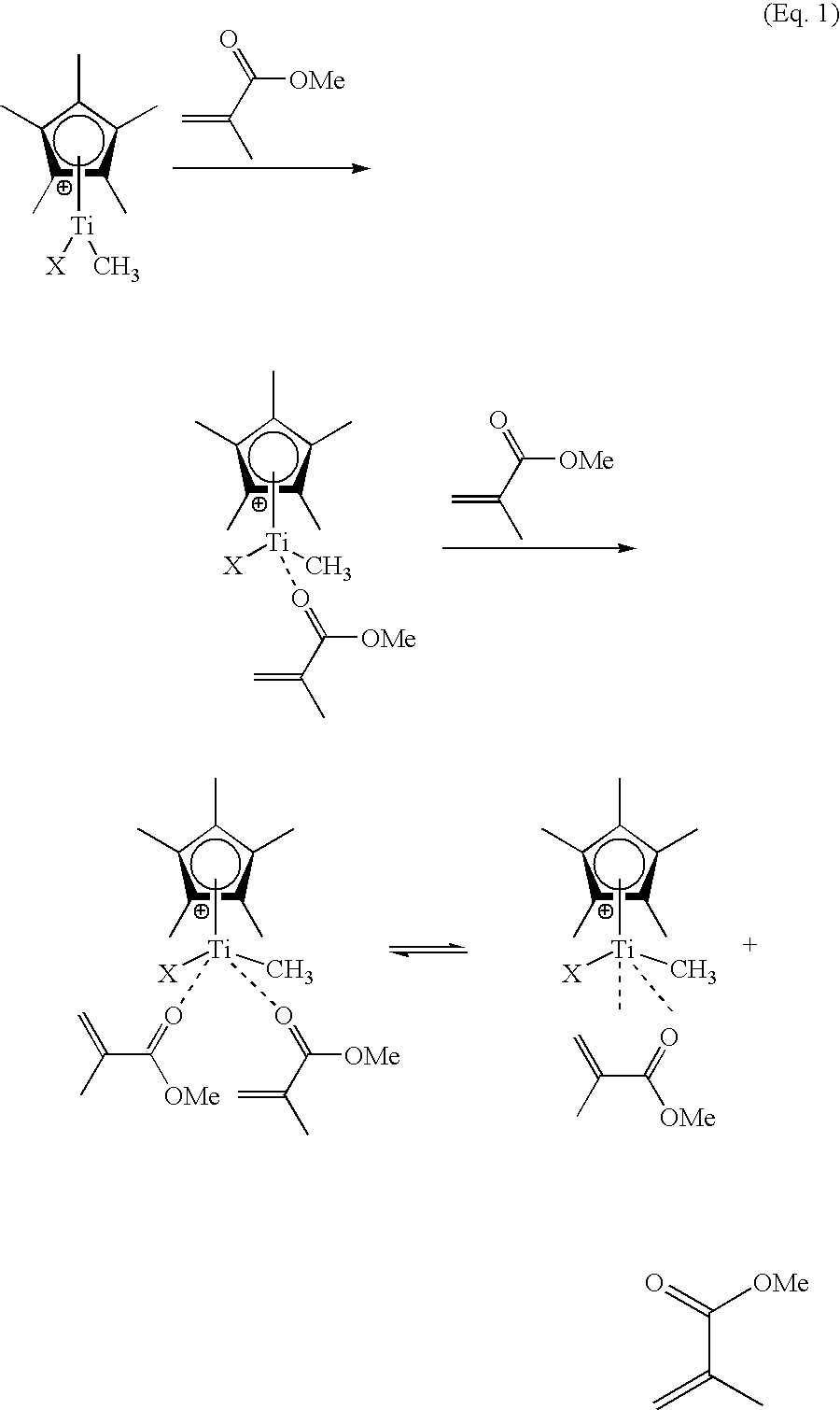Cyclopentadienyl-containing low-valent early transition metal olefin polymerization catalysts
a transition metal and catalyst technology, applied in the field of cyclopentadienyl-containing low-valent transition metal catalysts, can solve the problems of incompatibility with functionalized and inability to control stereoregularity
- Summary
- Abstract
- Description
- Claims
- Application Information
AI Technical Summary
Benefits of technology
Problems solved by technology
Method used
Image
Examples
example 1
Polymerization of Styrene Catalyzed by an In Situ Generated Ti(III) Catalyst
[0062]A portion of dry styrene (2.0 milliliters (mL), 19 mmol) was vacuum transferred into a 50 mL flame-dried oxygen-free, moisture-free flask having a side outlet fitted with a rubber septum and equipped with a magnetic stirrer and was placed in a 21° C. water bath. A 2 mL Wilmad screw-capped vial and an air-tight syringe were brought into a glovebox and 7.0 mg (31 μmol) of Cp*TiMe3, 28.0 mg (31.0 μmol) of (C6F5)3C+B(C6F5)4−, and about 1 mL of toluene was charged into the vial, followed by vigorous shaking for 2 minutes to allow the reagents to react. Then 15 mg (225 μmol) of Zn powder was added to the solution and the mixture allowed to stand for 75 min. The solution color changed from orange to dark brownish-green. The solution was removed from the glovebox and the supernatant injected into the stirring styrene solution by syringe. After vigorously stirring for 15 min, the reaction was quenched by additi...
example 2
Polymerization of MMA Catalyzed by an In Situ Generated Ti(III) Catalyst
[0063]A portion of dry methylmethacrylate (MMA) (2.0 milliliters (mL), 19 mmol) was vacuum transferred to a 50 mL flame-dried oxygen-free, moisture-free flask having a side outlet fitted with a rubber septum and equipped with a magnetic stirrer and was placed in a 21° C. water bath. A 2 mL Wilmad screw-capped vial and an air-tight syringe were brought into a glovebox and 7.0 mg (31 μmol) of Cp*TiMe3, 26.0 mg (29.0 μmol) of (C6F5)3C+B(C6F5)4−, and about 1 mL of toluene was charged into the vial, followed by vigorous shaking for 2 min to allow the reagents to react. Slightly less (C6H5)3C+B(C6F5)4− than Cp*TiMe3 in molar ratio was used to ensure complete reaction of (C6H5)3C+B(C6F5)4− and to eliminate possible cationic polymerization initiated by (C6H5)3C+. Then, 15 mg (225 μmol) of Zn powder was added to the solution and the mixture allowed to stand for 80 min. The solution color changed from orange to dark brown...
example 3
Copolymerization of Styrene with MMA Catalyzed by In Situ Generation of Ti(III) Species with Zn Assisted Reduction
[0065]In a glovebox, a 50 mL flame-dried oxygen-free, moisture-free flask having a side outlet fitted with a rubber septum and equipped with a magnetic stirrer was charged with 7.7 mg (34 μmol) of Cp*TiMe3, 26.8 mg (29 μmol) of (C6H5)3C+B(C6F5)4−, and 1 mL of dry toluene. After 2 min with occasional shaking, 15 mg Zn powder was added to the flask. The flask was placed in a 55° C. water bath and stirred for 25 min. The solution color changed from orange to brownish-green. Then the flask was placed in another 21° C. water bath for 15 min to reach thermal equilibrium. A portion (10 mL, 94 mmol) of dry 1:1 molar MMA / styrene mixture was injected into the stirring catalyst solution by syringe. After 180 min, the reaction was quenched by addition of 20 mL MeOH and volatiles removed under vacuum. The solid polymeric material (6 g) was extracted with a 1:3 toluene / MeOH mixture. T...
PUM
| Property | Measurement | Unit |
|---|---|---|
| mol % | aaaaa | aaaaa |
| temperatures | aaaaa | aaaaa |
| temperatures | aaaaa | aaaaa |
Abstract
Description
Claims
Application Information
 Login to View More
Login to View More - R&D
- Intellectual Property
- Life Sciences
- Materials
- Tech Scout
- Unparalleled Data Quality
- Higher Quality Content
- 60% Fewer Hallucinations
Browse by: Latest US Patents, China's latest patents, Technical Efficacy Thesaurus, Application Domain, Technology Topic, Popular Technical Reports.
© 2025 PatSnap. All rights reserved.Legal|Privacy policy|Modern Slavery Act Transparency Statement|Sitemap|About US| Contact US: help@patsnap.com



